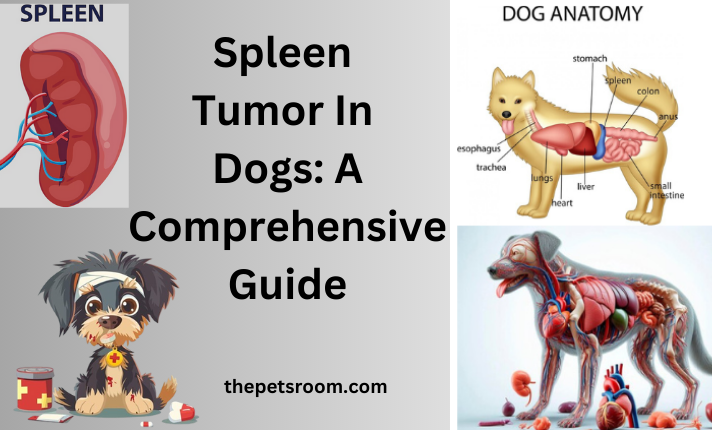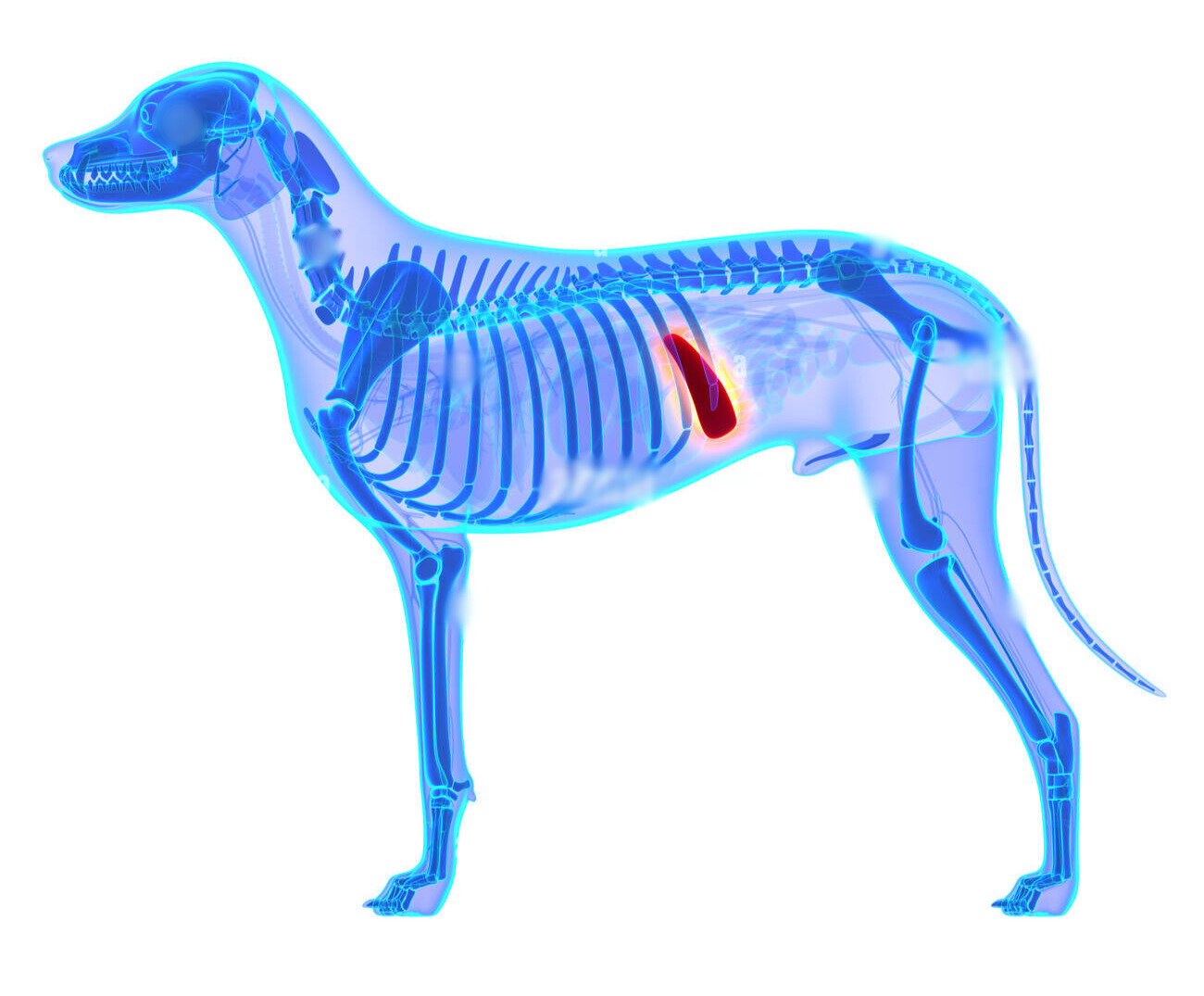Spleen tumor in dogs are common, especially in older dogs, and maybe both malignant or benign. The most frequent malignant splenic tumor in dogs is splenic hemangiosarcoma, which develops from vascular endothelial cells and has a terrible outcome. According to the “double two-thirds” rule, two-thirds of canine splenic mass lesions are malignant, with hemangiosarcoma accounting for two-thirds of them as well. Non-neoplastic nodular disorders of the spleen in dogs include nodular hyperplasia and splenic hematoma. Nodular hyperplasia is a benign proliferation of cells that occurs normally in the spleen and is one of the leading causes of splenic mass lesions in dogs.
Splenic hematoma is a collection of blood in the splenic parenchyma produced by a hemorrhage or interrupted blood flow in the spleen. The causes of parenchymal disruption are many, including trauma, benign nodular hyperplasia, and hemangiosarcoma, although the majority are idiopathic. Although the clinical and imaging aspects of canine splenic mass lesions have been studied in numerous research, the histology of canine splenic mass lesions has not been explored in many nations, including the Republic of Korea.
Types Of Spleen Tumor In Dogs
Spleen Malignant tumors
Splenic hemangiosarcoma is a frequent malignant tumor that develops in the spleen of dogs, particularly older canines such as German Shepherds, Labrador Retrievers, and Golden Retrievers. Hemangiosarcoma is a cancer that develops from the cells that line blood arteries and is very deadly since it has the potential to spread to other organs.
Other malignant tumours: Aside from hemangiosarcoma, additional malignant tumors that may affect dogs’ spleens include lymphoma, leiomyosarcoma, fibrosarcoma, and mast cell tumors.
Spleen Benign Tumors
Benign spleen tumors are not cancer-causing, yet they are easily confused with malignant tumors. When veterinarians discover a tumor on the spleen, they may suggest further testing to rule out more serious disorders. Benign tumors do not spread throughout the body and do not represent a danger of metastasis. Many benign tumors may still be removed and have a favorable prognosis if detected early.

Symptoms Of Spleen Tumor In Dogs
Spleen tumors in dogs may be benign or malignant, and they are usually difficult to identify without surgery. Symptoms of spleen tumors in dogs vary, although most often include weakness or collapse, abdominal distension, pale gums, decreased appetite, and weight loss. Diagnostic testing like ultrasonography and blood work may assist in identifying the existence of a spleen tumor and examine the dog’s general health.
Spleen tumors in dogs are normally treated surgically, with a splenectomy. This is also a diagnostic and medicinal surgery since it removes the malignancy and offers tissue for pathological evaluation. The outlook for dogs with spleen tumors varies according to the kind and stage of the tumor, with malignant tumors such as hemangiosarcoma having a bad prognosis. However, early identification and treatment may increase the likelihood of a positive result. Dog owners should be aware of the signs of spleen tumors and seek veterinarian treatment if they observe any changes in their pet’s condition.
Characteristics of Canine Splenic Mass Lesions
The maximum lesion size varies significantly between malignant and benign tumors, with malignant tumors typically being larger. Tumor margination can indicate the type of tumor. Malignant splenic tumors frequently have irregular margins, whereas benign tumors generally have regular margins. Precontrast lesion attenuation is an important imaging characteristic.
A diagnostic flowchart can improve the survival rate of patients with splenic malignant tumors. For instance, one study discovered that using a diagnostic flowchart based on imaging characteristics was effective in distinguishing between malignant and benign tumors. Use fine needle aspiration or magnetic resonance imaging to identify tumor type before surgery and histopathology.
10 Steps to Diagnosing and Treating Tumor in Dogs
- The first step in identifying a tumor in dogs is to locate the lump or bump.
- To assess if the lump is benign or cancerous, a fine needle aspiration or biopsy is required. This method entails obtaining a tiny sample of the tumor for testing.
- Blood tests and urinalysis: Blood testing and urine may give useful information about the dog’s general health and assist in identifying probable cancer red flags.
- Imaging tests, such as X-rays, ultrasounds, and CT scans, may assist detect the tumor’s position and size, as well as if the cancer has spread to other regions of the body.
- Diagnosis: Based on the test findings, a diagnosis may be formed. The veterinarian will decide if the tumor is benign or malignant and the kind of malignancy.
- Staging: Once cancer has been diagnosed, it will be staged. Staging determines the cancer’s extent and guides therapy recommendations.
- Treatment Options: Cancer treatment options in dogs include surgery, chemotherapy, radiation therapy, and immunotherapy.
- The surgeon may recommend removing the tumor with surgery which is called as splenectomy or partial splenectomy, if it is small and hasn’t metastasized.
- To kill cancer cells and stop them from metastasizing, your doctor may recommend chemotherapy or radiation therapy.
- Care after treatment: To make sure the dog doesn’t get cancer again, it has to be checked often. This might involve routine veterinarian checks, blood testing, and imaging tests.
Faqs
Which spleen tumor is most common in dogs?
The most common malignant tumor is splenic hemangiosarcoma, whereas benign tumors include nodular hyperplasia and splenic hematoma.
What are the signs of a spleen tumor in dogs?
Depending on the size and nature of the tumor, a dog’s spleen tumor may present with different symptoms. Typical signs and symptoms include of:
- Lethargy or Weakness: Dogs may exhibit signs of unusual fatigue or show reluctance to move.
- Bloating or Swelling in the Abdomen: Visible bloating or swelling in the abdomen may be a sign of an enlarged spleen.
- Loss of Appetite: Dogs may become less interested in eating, which could lead to weight loss.
- Weight Loss: A spleen tumor may be the cause of an inexplicable drop in body weight.
- Pale Gums: If the tumor is causing internal bleeding, pale or whitish gums may be an indication of anemia.
- Panting or Labored Breathing: Blood loss or abdominal pressure might cause breathing difficulties.
In dogs, how spleen tumor is identified?
It is common practice to monitor the dog’s vitals and look for signs of a spleen tumor using imaging techniques such as ultrasonography and blood tests.
Can dogs live without a spleen?
Dogs can indeed survive without a spleen. Splenectomy, or surgical removal of the spleen, is a medical procedure that may be required to cure illnesses, tumors, or ruptures of the spleen. Even though the spleen aids in the immune system and filters blood, among other vital tasks, its absence can be made up for by other organs and tissues in the body.
Living without a spleen does come with certain hazards and precautions, though.
- Increased Infection Risk: Dogs lacking a spleen may be more prone to infections since the spleen aids in the defense against some infections. It’s critical to keep a close eye out for any symptoms of disease in your dog and to seek medical attention as soon as necessary.
- Vaccines and Preventive Care: In order to guard against infections, dogs lacking a spleen may require extra vaccines and preventive care. Advice regarding the proper vaccines and care can be obtained from your veterinarian.
- Diet and Lifestyle: Keeping up a healthy diet and way of living will benefit your dog’s immune system and general well-being. It’s essential to take your dog to the vet on a regular basis to monitor health issues and handle any problems.
Is spleen tumor painful in dog?
Yes, a dog may experience pain from a spleen tumor. The size and type of the tumor will determine how painful and uncomfortable it is. In dogs suffering from spleen tumors, the following symptoms may indicate pain and discomfort:
- Weakness or lethargy
- Bloating or swelling in the abdomen
- Difficulty breathing
- Pale gums
- Diminished weight
- Appetite loss
- Abdominal pain upon contact
- Swelling or abrupt weakening spells
For an accurate diagnosis and treatment plan, it is imperative that you visit a veterinarian if you believe your dog has a spleen tumor. Your pet’s quality of life can be enhanced and the condition managed with the aid of early detection and intervention.
Conclusion
In Conclusion, spleen tumor in dogs may be either malignant (splenic hemangiosarcoma) or benign (nodular hyperplasia or splenic hematoma). Recognizing the symptoms early, establishing a good diagnosis by imaging and histology, and pursuing suitable treatment choices like as surgery or chemotherapy may have a substantial influence on a dog’s prognosis and quality of life. Regular veterinarian check-ups and post-treatment monitoring are critical for controlling spleen tumours and providing the best possible result for afflicted pets.
Furthermore, it is imperative that dog owners watch out for any odd signals or behaviors in their pets and act quickly to address them. Effective management of spleen cancers frequently depends on early intervention. It is important for owners to stay in regular contact with their veterinarians, follow prescribed follow-up schedules, and exercise caution when it comes to their dog’s general health and wellbeing. Supplemental nutrition, a stress-free atmosphere, and activity levels suited for the dog’s condition can all help speed up the healing process. The lifespan and quality of life of dogs with spleen tumors can be greatly improved by pet owners working closely with veterinary specialists and giving careful care at home.













The degree to which I appreciate your creations is equal to your own sentiment. Your sketch is tasteful, and the authored material is stylish. Yet, you seem uneasy about the prospect of embarking on something that may cause unease. I agree that you’ll be able to address this matter efficiently.